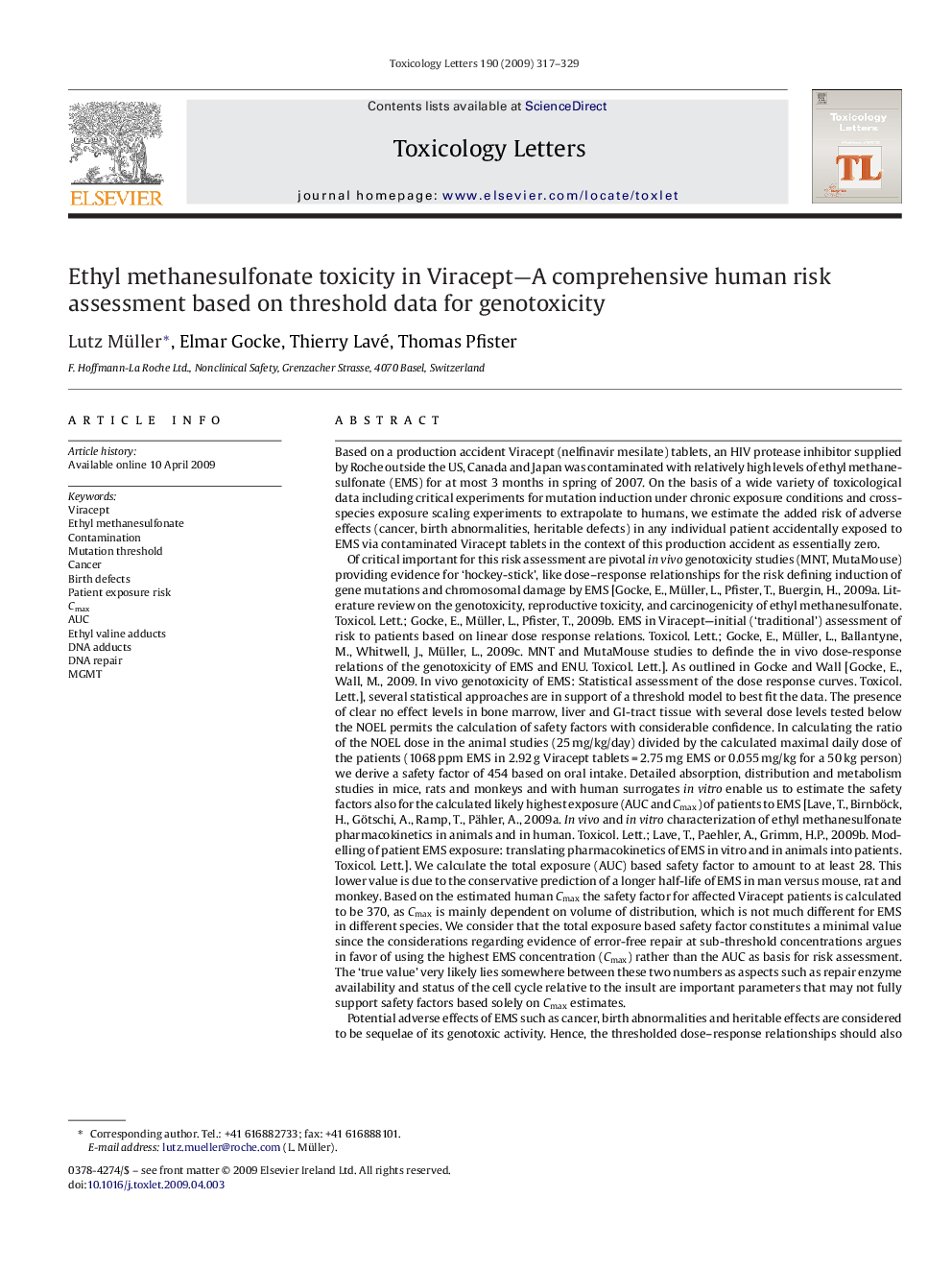| کد مقاله | کد نشریه | سال انتشار | مقاله انگلیسی | نسخه تمام متن |
|---|---|---|---|---|
| 2600826 | 1562643 | 2009 | 13 صفحه PDF | دانلود رایگان |

Based on a production accident Viracept (nelfinavir mesilate) tablets, an HIV protease inhibitor supplied by Roche outside the US, Canada and Japan was contaminated with relatively high levels of ethyl methanesulfonate (EMS) for at most 3 months in spring of 2007. On the basis of a wide variety of toxicological data including critical experiments for mutation induction under chronic exposure conditions and cross-species exposure scaling experiments to extrapolate to humans, we estimate the added risk of adverse effects (cancer, birth abnormalities, heritable defects) in any individual patient accidentally exposed to EMS via contaminated Viracept tablets in the context of this production accident as essentially zero.Of critical important for this risk assessment are pivotal in vivo genotoxicity studies (MNT, MutaMouse) providing evidence for ‘hockey-stick’, like dose–response relationships for the risk defining induction of gene mutations and chromosomal damage by EMS [Gocke, E., Müller, L., Pfister, T., Buergin, H., 2009a. Literature review on the genotoxicity, reproductive toxicity, and carcinogenicity of ethyl methanesulfonate. Toxicol. Lett.; Gocke, E., Müller, L., Pfister, T., 2009b. EMS in Viracept—initial (‘traditional’) assessment of risk to patients based on linear dose response relations. Toxicol. Lett.; Gocke, E., Müller, L., Ballantyne, M., Whitwell, J., Müller, L., 2009c. MNT and MutaMouse studies to definde the in vivo dose-response relations of the genotoxicity of EMS and ENU. Toxicol. Lett.]. As outlined in Gocke and Wall [Gocke, E., Wall, M., 2009. In vivo genotoxicity of EMS: Statistical assessment of the dose response curves. Toxicol. Lett.], several statistical approaches are in support of a threshold model to best fit the data. The presence of clear no effect levels in bone marrow, liver and GI-tract tissue with several dose levels tested below the NOEL permits the calculation of safety factors with considerable confidence. In calculating the ratio of the NOEL dose in the animal studies (25 mg/kg/day) divided by the calculated maximal daily dose of the patients (1068 ppm EMS in 2.92 g Viracept tablets = 2.75 mg EMS or 0.055 mg/kg for a 50 kg person) we derive a safety factor of 454 based on oral intake. Detailed absorption, distribution and metabolism studies in mice, rats and monkeys and with human surrogates in vitro enable us to estimate the safety factors also for the calculated likely highest exposure (AUC and Cmax) of patients to EMS [Lave, T., Birnböck, H., Götschi, A., Ramp, T., Pähler, A., 2009a. In vivo and in vitro characterization of ethyl methanesulfonate pharmacokinetics in animals and in human. Toxicol. Lett.; Lave, T., Paehler, A., Grimm, H.P., 2009b. Modelling of patient EMS exposure: translating pharmacokinetics of EMS in vitro and in animals into patients. Toxicol. Lett.]. We calculate the total exposure (AUC) based safety factor to amount to at least 28. This lower value is due to the conservative prediction of a longer half-life of EMS in man versus mouse, rat and monkey. Based on the estimated human Cmax the safety factor for affected Viracept patients is calculated to be 370, as Cmax is mainly dependent on volume of distribution, which is not much different for EMS in different species. We consider that the total exposure based safety factor constitutes a minimal value since the considerations regarding evidence of error-free repair at sub-threshold concentrations argues in favor of using the highest EMS concentration (Cmax) rather than the AUC as basis for risk assessment. The ‘true value’ very likely lies somewhere between these two numbers as aspects such as repair enzyme availability and status of the cell cycle relative to the insult are important parameters that may not fully support safety factors based solely on Cmax estimates.Potential adverse effects of EMS such as cancer, birth abnormalities and heritable effects are considered to be sequelae of its genotoxic activity. Hence, the thresholded dose–response relationships should also apply to these endpoints. We also provide a comprehensive discussion of the specific disease situation of the HIV infected target population and potential influences of co-medications on the susceptibilities and repair capacities of EMS induced DNA lesions.
Journal: Toxicology Letters - Volume 190, Issue 3, 12 November 2009, Pages 317–329